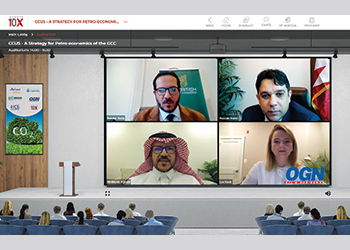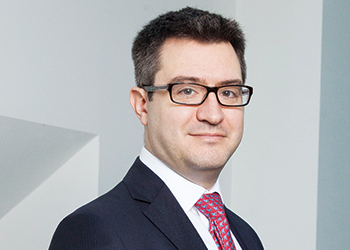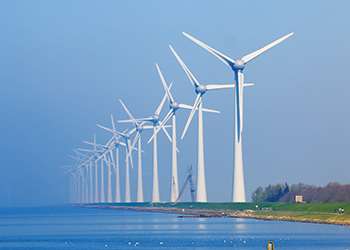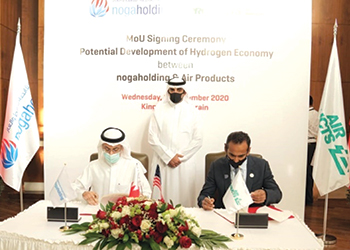
 Aerial drones provide state-of-the-art surveys of remote land and sea envioronments
Aerial drones provide state-of-the-art surveys of remote land and sea envioronments
Against the backdrop of the climate crisis and amidst global calls for a cleaner oil and gas sector, governments, investors and civil society are challenging the role of oil and gas companies in transforming the global energy system, writes Abdulaziz Khattak for OGN
In A rapidly changing world, technology helps solve old and new challenges with renewed vision, expanding horizons. But innovation alone means nothing without committed action.
Across the oil and gas sector, an emerging class of industrial pioneers is rising to the challenge. Introducing technologies that fast-track safer, more efficient and more sustainable production.
'We believe it’s time to celebrate these innovation leaders. To grow awareness, drive collaboration and inspire the whole sector to embrace a clean energy future,' says a spokesman for Axora, a new cross-industry innovation hub for digital solutions.
Against the backdrop of the climate crisis, governments, investors and civil society are challenging the role of oil and gas companies in transforming the global energy system.
The question is complex and multi-layered. Beyond fossil fuel products themselves, a significant proportion of global GHG emissions are caused by the production process itself, and atmospheric methane leaks in particular.
According to International Energy Agency’s (IEA) World Energy Outlook report, 15 per cent of global energy GHG emissions come from the process of getting oil and gas out of the ground.
In the face of this and other urgent challenges such as price volatility amid the Covid-19 pandemic, leading industrials are looking to technology to change the way oil and gas is discovered, drilled and produced. These strategic initiatives are being supported by an increasingly generous public sector.
From robotic drills to renewable energy grids, drone exploration to data collection and analytics, today’s flourishing tech ecosystem is driving a cleaner, more sustainable operating model for upstream energy.
Axora in collaboration with the Boston Consulting Group researched companies in the oil and gas sector around the world. It benchmarking their commitment to innovation and R&D investment, with a special focus on sustainability outcomes.
AUTONOMOUS MACHINERY
A new generation of unmanned vehicles is helping to propel sustainability and environmental standards forward, from exploration to asset inspections and even full platform automation. These autonomous robots can operate in harsher and less accessible areas than humans, which means better safety and reduced environmental risk.
Unmanned systems such as aerial drones and underwater vehicles provide state-of-the-art surveys of remote land and sea environments. In addition, the latest robotic drilling solutions enable full platform automation, reducing the need for human presence on offshore rigs.
Autonomous machinery improve sustainability by reducing ecological footprint of exploration, reducing impact on land and marine wildlife, and through unmanned operations improve worker safety.
The innovation leader in this segment is energy giant Total, which is pioneering an automated drone system to survey the harshest desert terrain in Abu Dhabi, the UAE, in partnership with the Abu Dhabi National Oil Company (Adnoc).
A remotely operated fleet of drones drop dart-shaped sensors over the exploration area to deliver high resolution 3D and 4D sub surface images in real time. The sensors are later retrieved by unmanned vehicles.
Billed as the world’s first automated seismic acquisition system, these drones can make exploration safer, more efficient and less ecologically intrusive. Above 10 sq km can be surveyed daily by the drone fleet
'Using drones helps us reduce the environmental footprint of our onshore exploration campaigns,' says Dominique Janodet, Vice President R&D, Total Exploration and Production.
ELECTRIFICATION
Electricity is a far cleaner, more reliable alternative to the high maintenance gas turbines traditionally used to power upstream oil and gas operations.
The infrastructure for carrying electric power from land to offshore platforms has already been pioneered by industry – and could help to move clean energy between countries and continents.
Subsea cables are an increasingly reliable way to deliver electricity to remote platforms, removing the need for costly diesel backup systems. The electricity can be generated by national grids or sustainable sources such as wind turbines, geothermal or hydroelectric.
Electrification improves sustainability by removing the need for carbon-intensive gas turbines, improved power reliability and removes need for diesel backup, and future-proofs production for clean energy transition.
Norwegian company Equinor is electrifying its giant Johan Sverdrup offshore field in the North Sea via subsea cables from the Norwegian mainland.
With over 200 km of cable already laid on the sea bed, including fibre optics for remote communications and monitoring, this solution is making Johan Sverdrup one of the world's most carbon-efficient fields.
Once completed, the solution will save around 460,000 tonnes of CO2 per year, the rough equivalent of 230,000 cars, with total production emissions set to be 20 times lower than average on the continental shelf.
'By choosing land-based power, we see the potential for cutting more than 1.3 million tonnes of CO2 per year,' says Arne Sigve Nylund, Executive Vice President, Equinor.
RENEWABLE & LOW CARBON ENERGY
As the global transition to net zero emissions gathers pace, renewable and low carbon energy solutions like wind, solar power and hydrogen from natural gas are increasingly viable for powering energy production at scale.
The focus of much government investment, these solutions have the potential to yield lasting sustainability dividends as a core component of the world’s energy infrastructure.
Floating solar and wind farms can power remote and offshore operations and reduce the need for gas turbines.
Natural gas can be reformed into clean burning hydrogen gas and decarbonised at source using carbon capture and storage technology before blending hydrogen within the existing natural gas networks.
Renewable and low carbon energy improve sustainability by virtually eliminating CO2 emissions from production, accelerating global energy transition, and driving public-private infrastructure partnerships.
At St Fergus in Scotland, Pale Blue Dot Energy’s Acorn hydrogen and carbon capture and storage (CCS) projects are deploying new technologies to convert natural gas into clean burning hydrogen.
With the help of substantial government funding, the company’s St Fergus facility will reform offshore natural gas into hydrogen, capturing and storing the CO2 created underground. The hydrogen will then be blended into existing pipelines that supply homes, offices and factories. About 35 per cent of UK’s natural gas supply could be decarbonised at St Fergus.
'Blending as little as 2 per cent hydrogen into the gas grid at St Fergus would remove 400 kilo tons of CO2 a year from the energy system,' says Sam Gomersall, Commercial Director, Pale Blue Dot Energy.
The Aberdeen Vision project also explored the potential for a purpose-built hydrogen pipeline. This would allow for the conversion of Aberdeen to a 20 per cent hydrogen blend which in time could grow to a 100 per cent hydrogen system.
DIGITALISATION
The Industrial Internet of Things (IIoT) is driving safer, more sustainable and energy efficient operations in upstream oil and gas.
With the latest data collection and advanced analytics tools, remote monitoring stations can become aware of any potential issues before they happen, reducing the risk of asset failure and damaging leaks.
Sophisticated sensing hardware is installed onsite, with inbuilt connectivity and full systems integration. This means data can be collected and processed in real time with pinpoint accuracy, using the latest artificial intelligence and algorithm-driven analytics.
Digitalisation improves sustainability by protecting the environment by preventing leaks, reducing the risk of greenhouse gas emissions, especially methane, and improving energy efficiency as well as safety.
GE Energy operates three iCenters in Florence (Italy), Houston (US) and Kuala Lumpur (Malaysia) to achieve 24/7 remote monitoring of more than 800 upstream assets around the globe.
With the ability to collect and analyse vast datasets, the team of diagnostic engineers can spot any deviations from normal performance early, helping to mitigate the risk of costly downtime.
This helps to protect asset integrity, maximise productivity gains and minimise leaks and other risks to the environment as well as improving worker safety.
'By looking at today’s data, we are able to see tomorrow’s potential issues,' says Gionata Ruggiero, Service Engineering Manager, GE Energy.
CONCLUSION
Successful transformation strategies can look very different from one organisation to another. And varying resources and requirements make it hard to know where to start.
Whether an organisation is already a digital leader or is still in the discovery phase, there are some strategies to help it move sustainability forwards within its operations.
• Analyse current assets and model projected financial, production and emissions scenarios.
• Establish the long term business opportunities and risks from climate change and sustainability issues.
• Develop a detailed business case and define decision makers to choose strategic priorities.
• Once strategic priorities are defined, build a detailed roadmap for implementation.















































































